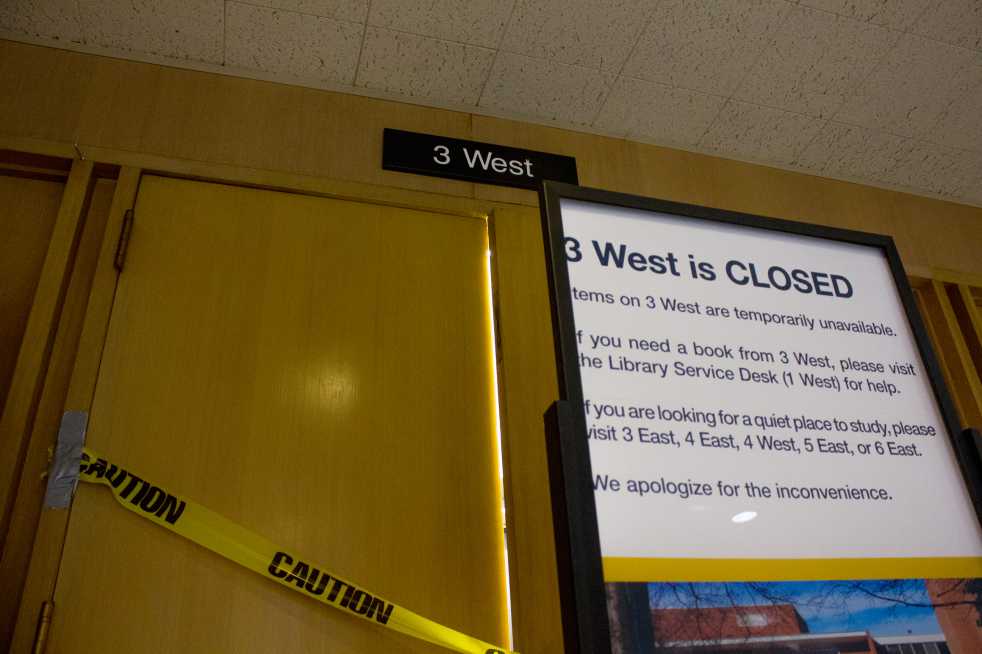Earlier last week, the library announced the closing of the third floor west book stacks area in order to remove asbestos that was discovered there.
According to Ameet Doshi, User Engagement and Assessment Coordinator at the library, the heavy-duty cleaning crew was performing their cleaning tasks when some of the tiles buckled. The crew identified asbestos underneath the tiles and Environmental Health and Safety (EHS) was brought to the scene.
“When EHS tests something, everything gets shut down,” Doshi said. “No one is allowed in the tile area.”
No airborne asbestos particles have been identified in the area yet. These particles are typically the leading cause of asbestos related illnesses, according to the U.S. Environmental Protection Agency. In fact, it is the tiled area that holds the bookshelves and bound volumes that was affected by asbestos—more specifically, the floor only.
In addition, the area will be subject to a negative pressure seal to prevent any of the asbestos from leaking outside. The books in the area will also be subject to a cleaning procedure.
“The books that were next to the floor are going to be cleaned as a precaution, and [EHS] is testing everything,” said Jeff Carrico, Associate Dean for Scholarly Communication and Access at the library. “The clean materials that have been double wiped will be exiting [3 West], re-shelved to the clean part of the library and then they’ll take care of the floor.”
No airborne asbestos particles have been identified in the area.
“The print collection—and they’re doing this out of an abundance of caution—will be cleaned individually,” Doshi said. “That’s 86,000 volumes.”
This large collection will be moved to the third floor east collection area, which is currently occupied by government documents.
“Nowadays, most government documents are being generated electronically…and the public doesn’t really walk in and grab one,” Carrico said. “Those materials are going to be relocated from the third floor to the basement, where we have a high density sort of storage for this type of thing. The materials in third floor west will be moved to third floor east so the public can still access them.”
In the time that the library material on third floor west is inaccessible to students, the library is relying on its interlibrary partners, particularly Emory, to get faster access to those materials.
“With all of our partners, especially Emory, trying to get as quick access to those materials as possible—that’s going to be our emphasis,” Doshi said.
However, the asbestos incident has allowed a larger magnification of the library’s desire to increase its collaboration and relationship with Emory.
“The library’s making lemonade out of lemons here, and we’re trying to improve access to the collections as aptly as we can, dealing with a bad situation and making the best out of it, particularly with our partners at Emory,” Doshi said. “That’s been a long term goal, and this is speeding it up.”
“We’re now in the beginnings of a heavy partnership with Emory,” Carrico said. “We’re going to start a borrowing program with them where we’ll have daily deliveries of materials.”
According to Carrico, the actual source of funding for the new cost has yet to be determined, and the desire to renovate the library in 2020 beckons the question of the validity of a large investment in improving the current state of the facility.
“If you something like that, make that floor, make that space, if you make it available for ‘x’ that means in some other location you can’t do something else—so it’s a tradeoff,” Carrico said. “Because the library is looking to renovate the facility, is it the appropriate time to do that or should we do something else?”
These renovations are part of the library’s 2020 plan, which seeks to modernize the library to meet students needs in an electronic age.
The plan began by defining the space utilization for the library in 2011 against what the plan for 2020 should be. In terms of available space, study space made up about 29 percent in 2011 and would be increased to 49 percent in 2020, stacks; bookshelves and collections made up about 46 percent and would be reduced to 24 percent and offices made up 14 percent and would increase to 23 percent.
According to a release from the library, the asbestos related closure is expected to last six to eight weeks.
“The students can expect that the library is doing everything in its power to provide a safe, secure environment to study and spend their evenings and their time,” Carrico said. “As a result of us doing that, we are pursuing two aspects: getting the content out of the icky zone, and moving it to the area that we are clearing it for.”
